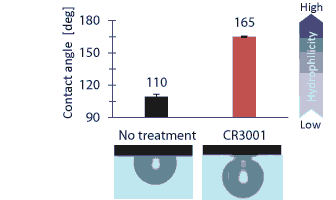Lipidure®-CR3001
MPC-based surface modifier
Lipidure®-CR3001 for Silicone
The Lipidure®-CR3001 is a surface modifier for metals and silicone rubber that can provide excellent hydrophilicity and excellent biocompatibility.
g. Hydrophilization of Silicone Rubber Surface .g
A silicone rubber sheet was modified with Lipidure®-CR3001.
Contact angle (air in water) of the CR3001-modified surface was measured to confirm the improvement of hydrophilicity.



g. Coating Procedure .g
|
Preparation of coating liquid
① Dissolve Lipidure® CR3001 in ethanol. *CR3001/ethanol = 1.0-4.0 wt% |
Surface modification
|
 ②Drop CR3001 solution into 0.1 mM HCl aq. soln. with stirring. * CR3001 soln./HCl soln. = 1/1 (wt) ②Drop CR3001 solution into 0.1 mM HCl aq. soln. with stirring. * CR3001 soln./HCl soln. = 1/1 (wt) |
 ②Dip coat with the coating liquid. * The coating liquid should be prepared immediately before use ②Dip coat with the coating liquid. * The coating liquid should be prepared immediately before use |
|
|
 ③Dry in an oven at 230°F for 30 min. to immobilize Lipidure®-CR3001 on the substrate. ③Dry in an oven at 230°F for 30 min. to immobilize Lipidure®-CR3001 on the substrate. |
 ④Complete. * Residual CR3001 can be removed by rinsing with water. ④Complete. * Residual CR3001 can be removed by rinsing with water. |
g.Mechanism of Immobilizing Lipidure®-CR3001 .g
MPC : A Source of Ultra High Hydrophilicity

MPC is a methacrylic monomer having phosphoryl choline group.
a Phosphoryl choline is a hydrophilic part of phospholipid, which
exists on cell membrane.
a Phosphoryl choline coating imparts excellent biocompatibility
and excellent hydrophilicity onto the substrate.
Above Img: 2-Methacryloyloxyethyl Phosphoryl Choline
Alkoxy silane: A crosslinking point
1. Alkoxy silane group is hydrolyzed in an acidic condition to form silanol group [-Si(OH)3].
2. In coating process, hydrogen bond is formed between the silanol and hydroxy group on the substrate.
3. Dehydration condensation occurs in heating process to form Si-O covalent bond.

MPC-based METAL surface modifier
Lipidure®-CR3001 for Metal
The Lipidure®-CR3001 is a metal surface modifier that can provide excellent hydrophilicity, and excellent biocompatibility.
The Lipidure®-CR3001 contains alkoxy silane group, which can bind the polymer onto the metal substrate by making strong hydrogen bond, and covalent bond.
g. Coating Procedure .g
A metal foil, SUS 304 was used as an example, was modified with Lipidure®-CR3001.
Contact angle of the substrate modified with CR3001 was measured to confirm the improvement of hydrophobicity.
Coating solution Lipidure®-CR3001 EtOH solution was dropped into the same weight of hydrochloric acid (pH≈4) with stirring, immediately before use.
Concentration Final concentration of CR3001 was 2.0 wt%
![]() SUS 304
SUS 304
↓
Cleaned by Ultra sonication in organic solvent.
↓
Treated with 35% nitric acid to form oxide film.
↓
Dip coated with coating solution.
↓
![]() SUS 304 + adsorbed CR3001
SUS 304 + adsorbed CR3001
↓
Dried in an oven at 110°C for 30 min to silanize the surface.
↓
![]() SUS 304+ immobilized CR3001
SUS 304+ immobilized CR3001
Washed with purified water.
↓
Evaluation
Contact angle was measured by Captive bubble method in water below.

g. Elimination of Protein Adsorption .g
Metal foils modified with Lipidure®-CR3001 were characterized in terms of protein adsorption property.
![]() SUS 304 or titanium (1 cm X 1cm)
SUS 304 or titanium (1 cm X 1cm)
↓ Modified with Lipidure®-CR3001 (described above)
![]() CR3001 treated
CR3001 treated
↓ Set in a 12-well plate
![]()
↓
2 mL of Horseradish peroxidase (Wako Pure Chemical) was added. (10 mg/mL for SUS, 3 mg/mL for Ti)
↓
Gently shaken for 15 min. in a room temperature
↓
Washed three times with 2 mL of PBS containing 0.05% Tween20
↓Set in a new plate
![]()
Colorimetric substrate was added and reacted in a room temperature for 10 min.
Quenched with sulfuric acid.
↓
Evaluation
Absorbance at 450 nm was measured.
Lipidure®-CR3001 completely eliminated protein adsorption on SUS 304, and titanium.

g. Silanized MPC Polymer .g
Lipidure®-CR3001 is synthetic copolymer combining MPC unit and alkoxy silane unit.
The MPC unit is the source of excellent biocompatibility, and excellent hydrophilicity, and the alkoxy silane group can bind
the polymer on the substrate surface by making strong hydrogen bond and Si-O covalent bond.
What's MPC
 MPC consists of phosphoryl choline group and methacrylic group.
MPC consists of phosphoryl choline group and methacrylic group.
- Phosphoryl choline group
a Hydrophilic part of phospholipid, which exists on cell membrane.
a Source of excellent biocompatibility and excellent hydrophilicity.
- Methacrylic group
a Polymerizable with various comonomers
Above Img: 2-Methacryloyloxyethyl Phosphoryl Choline
Mechanism of immobilizing Lipidure®-CR3001
1. Alkoxy silane group is hydrolysed in an acid condition to form silanol group [-Si(OH)3].
2. In coating process, hydrogen bond is constructed between the silanol and hydroxy group on the substrate.
3. Dehydration condensation occurs in heating process to form Si-O covalent bond.









 ③
③